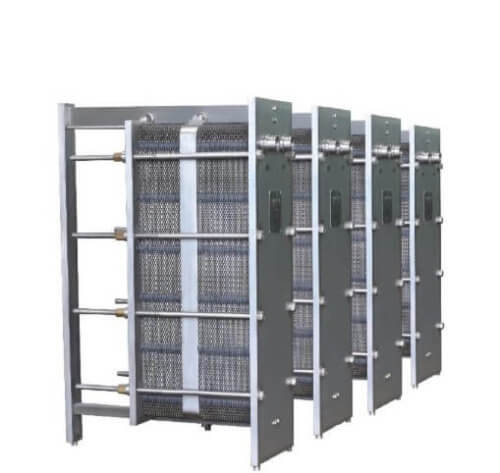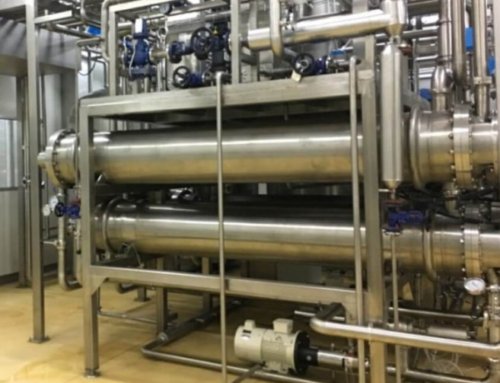Project Description
Plate Heat Exchanger
Application Of Plate Heat Exchanger
Plate-type heat exchangers find extensive application in the liquid food and beverage processing field due to their efficiency, versatility, and hygienic design. Here are some common applications:
- Pasteurization: Plate heat exchangers are widely used for pasteurizing liquid foods such as milk, fruit juices, and sauces. They effectively heat the product to a specific temperature for a certain period, killing harmful bacteria while preserving the flavor and nutritional value.
- Cooling: After pasteurization or cooking processes, liquids often need to be rapidly cooled to prevent overcooking or spoilage. Plate heat exchangers can efficiently cool down liquids by circulating cold water or refrigerants through the plates.
- Sterilization: In beverage processing, particularly for sensitive products like fruit juices and dairy, sterilization is crucial for ensuring product safety and extending shelf life. Plate heat exchangers can be used for sterilizing liquid food such as juice or milk by exposing them to high temperatures for a short duration.
- Heating: Plate heat exchangers are employed to heat various liquid food products during manufacturing processes. For example, they can heat sauces, soups, or syrups to specific temperatures required for cooking or processing.
- Concentration: In the production of concentrated liquids like fruit juices or concentrates, plate heat exchangers are utilized to evaporate water from the product, resulting in a more concentrated solution.
- Wort Cooling in Brewing: In brewing, plate heat exchangers are used for rapidly cooling wort (the liquid extracted from mashing malted barley during the brewing process) before yeast is added for fermentation.
- Wine and Beer Production: Plate heat exchangers play a role in both the heating and cooling stages of wine and beer production, assisting in fermentation temperature control and stabilization processes.
- Cleaning-in-Place (CIP): Plate heat exchangers are designed for easy disassembly and cleaning, making them suitable for CIP systems commonly used in food and beverage processing plants to maintain hygiene standards.

Description Of Plate Heat Exchanger
The SUS304 plate heat exchanger is the core component of the plate pasteurizer, which is used widely in the food and beverage industry, which can cool or heat milk and dairy, juice and beverage, hot water, syrup, beer, liquid eggs, fruit and vegetable sauce through cooling or heating medium. it is composed of a group of corrugated metal plates, which assembled between a fixed frame board and a moveable clamping board and are tightened by the tightening bolts, the holes on plates form a channel for fluids to flow, and the heat will be transferred between two kinds of fluids. These plates are installed with sealing gaskets. The sealing gaskets play the sealing function on the channels between plates and make the liquids flow into adjacent channels. The number of plates are determined by flow, physical properties and temperature of liquids

Plate Heat Exchanger Structure
- The excellent structure design makes the material flow more even and improves heat transfer efficiency.
- Double-stage sealing structure and signal hole. If the sealing gasket is damaged, when the medium leaks from the first seal, the leakage problem can be found early through the signal hole and solved in time without causing mixing of heat exchange media.
- The buckle-type adhesive-free gasket makes the gasket have a longer service life, faster and more convenient heat exchange and reduces maintenance costs.
- The precise four-corner positioning system allows the upper and lower guide rods of the plates to be accurately embedded together. The multi-point positioning technology allows the plates to move forwards and backward without resistance to easily complete maintenance. It also allows the gasket to seal accurately, ensuring a longer service life of the heat exchanger.
- For materials with different viscosities, horizontal, vertical and W-shaped corrugated plates are available.
- The front plate is used for meeting higher requirements in food processing. The combination of the high-pressure depth, plate type and relatively few contacts make the running time longer and there will have no interruption. The diverting type can ensure that the liquid flows through the whole plate. The end diameter enables it to carry out CIP cleaning with the same fluid it uses during the use.
- The sealing gasket is not bonded by glue. Users can carry out easy replacement operation of the sealing gasket even when the plate suspends inside the frame.

Plate Heat Exchanger Technical Parameter And Feature
- The plate and frame material is SUS304 or SUS316L, sealing gasket is food grade NBR or EPDM with wear-resistance.
- The working temperature is -10℃ – +150℃
- Plate area configuration:0.01-1.3m^2, material capacity is 0.05T/H-1500T/H
- The plate is suitable for a wide range of material viscosity from 10CPS-5,000CPS.
- The heat transfer efficiency is high. Due to the small gap between the plates, the heat exchange fluid can obtain a high flow rate, and the heat exchange plates have grooves in the shape of concave and convex, which form turbulent flow when the fluid passes through. These factors can accelerate The heat transfer efficiency of the fluid.
- Compact structure and small footprint. Compared with other heat exchangers, the same footprint can have several times the heat transfer coefficient.
- Suitable for sterilization of heat-sensitive materials. Because the hot fluid passes through the thin layer at high speed, high-temperature sterilization is achieved, which is especially ideal for sterilizing heat-sensitive materials without overheating.
- Greater adaptability. As long as the number of heat exchange plates and the arrangement and combination of heat exchange plates are changed, various process requirements can be met and automatic control can be realized.
- Safe to operate, hygienic and easy to clean. Operates in a completely closed condition to prevent contamination; the structural characteristics ensure that the two fluids will not mix with each other; it can be cleaned by CIP without disassembly.
- Save heat energy. The plate heat exchanger combines heating and cooling in a set of heat exchangers in the milk pasteurization process. In this way, as long as the heated material is used as the heat source, the material that has just been fed into can be preheated, at the same time, the heated(pasteurized) material can also be cooled by the feed-into material, which saves a lot of heat energy.


